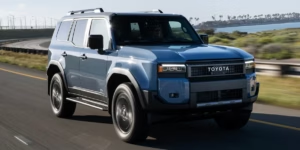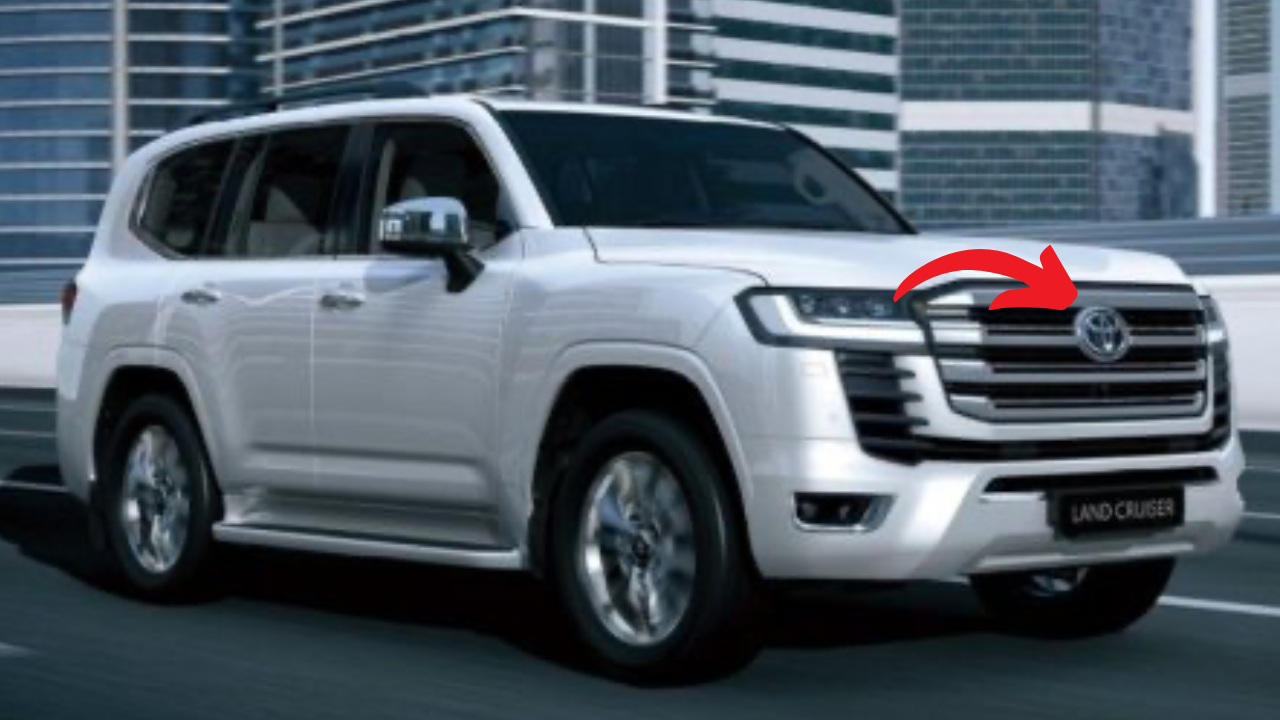The Toyota LandCruiser has long been an icon in Australia, revered for its rugged off-road capability, reliability, and ability to conquer the harshest outback conditions. In 2026, Toyota is set to elevate this legacy with the introduction of the first-ever LandCruiser 300 Series Hybrid, a petrol-electric powerhouse that promises to blend performance, efficiency, and environmental consciousness. Announced in June 2025, this hybrid variant marks a significant milestone in Toyota’s electrification strategy, bringing petrol power back to the LandCruiser lineup after a five-year absence. This article explores the 2026 Toyota LandCruiser Hybrid’s release date, specifications, pricing, and its impact on Australia’s automotive landscape, providing a comprehensive guide for enthusiasts and prospective buyers.
A New Era for the LandCruiser
The Toyota LandCruiser 300 Series, launched in Australia in 2022, replaced the venerable 200 Series with a modern platform, advanced technology, and a 3.3-litre twin-turbo V6 diesel engine producing 227kW of power and 700Nm of torque. While the diesel powertrain has been lauded for its capability, the absence of a petrol option left some enthusiasts yearning for the smooth, high-revving performance of earlier V8 models. The 2026 LandCruiser Hybrid addresses this gap, introducing a petrol-electric powertrain that Toyota Australia describes as a “performance hybrid” focused on power rather than solely fuel efficiency.
The hybrid variant was first revealed in the Middle East, where Toyota showcased its 3.4-litre twin-turbo petrol V6 paired with a single electric motor in a parallel hybrid arrangement. This setup, shared with the Toyota Tundra pick-up and the hybrid Lexus LX700h, delivers a combined output of 341kW and 790Nm, surpassing the diesel’s figures and making it the most powerful showroom-stock LandCruiser to date. Toyota’s decision to bring this hybrid to Australia reflects the brand’s commitment to offering diverse powertrains tailored to local demands, reinforcing the LandCruiser’s status as the “King Off The Road.”
Release Date in Australia
Toyota Australia has confirmed that the 2026 LandCruiser 300 Series Hybrid will arrive in local showrooms during the first half of 2026, likely between April and June. This timeline aligns with the brand’s planned rollout of the updated 2025 LandCruiser 300 Series, which introduces new infotainment and safety technologies. While exact dates for the hybrid’s launch remain undisclosed, Toyota is expected to open orders in late 2025, with dealers providing clearer delivery timelines closer to the launch. Given the LandCruiser’s popularity—12,274 units sold in Australia by September 2024—buyers should anticipate potential waitlists, especially for higher-spec variants.
Powertrain and Performance
At the heart of the 2026 LandCruiser Hybrid is a 3.4-litre twin-turbo petrol V6 engine, augmented by a single electric motor integrated into a 10-speed automatic transmission. Unlike Toyota’s conventional hybrids, such as the RAV4 or Camry, which use two electric motors and prioritize fuel economy, this parallel hybrid setup emphasizes performance. The system delivers a combined 341kW of power and 790Nm of torque, a significant leap over the diesel’s 227kW and 700Nm. These figures align with the Middle Eastern specification, though Toyota Australia has yet to confirm exact outputs for local models.
The hybrid powertrain is shared with the Toyota Tundra, which produces 326kW and 790Nm in Australia, suggesting similar performance for the LandCruiser. The electric motor provides instant torque, enhancing low-speed off-road traction and on-road responsiveness, while the petrol V6 ensures high-end power for highway cruising and towing. Toyota claims the system has been rigorously tested in extreme environments, including the deserts and mountains of the Middle East, ensuring reliability and off-road prowess. The LandCruiser Hybrid retains full-time four-wheel drive, low-range gearing, and advanced off-road features like Multi-Terrain Select (MTS) and Crawl Control, maintaining its legendary capability.

While fuel efficiency is not the primary focus, the hybrid system is expected to offer modest improvements over the diesel’s 8.9–10.7L/100km combined fuel consumption. Exact figures for Australia are pending, but the hybrid’s ability to run on electric power at low speeds could reduce urban fuel use. The LandCruiser’s 3500kg braked towing capacity is likely to remain unchanged, ensuring it can handle heavy loads for outback adventures or worksite duties.
Design and Features
The 2026 LandCruiser Hybrid is expected to carry over the 300 Series’ rugged, boxy design, with subtle tweaks to distinguish it from diesel models. Middle Eastern variants feature a sportier front bumper, but Australian models may retain the standard design to maintain consistency across the range. There’s uncertainty about whether “HEV” badges will adorn local models, as Toyota Australia’s marketing avoids explicit hybrid branding to emphasize performance. The 2025 LandCruiser 300 Series update, due in mid-2025, introduces a 12.3-inch digital instrument cluster and infotainment touchscreen for higher grades (VX, Sahara, GR Sport, Sahara ZX), along with connected navigation, wireless Apple CarPlay, and over-the-air updates. These upgrades will carry over to the hybrid.
Lower grades (GX, GXL) will feature an 8-inch touchscreen and a 7-inch instrument display, with physical climate controls standardized across the range for improved usability. Safety enhancements include lane-centring assist, emergency steering assist, and a safe exit assist function for blind-spot monitoring. The GR Sport variant, a likely candidate for the hybrid powertrain, adds unique features like a rear torque-sensing limited-slip differential and Electronic Kinetic Dynamic Suspension System (E-KDSS), optimizing on- and off-road performance. Interior comforts, such as heated and ventilated seats, a moonroof, and wireless charging, will continue to cater to luxury buyers.
Pricing Expectations
Pricing for the 2026 LandCruiser Hybrid remains unconfirmed, but it is expected to command a premium over the diesel-powered 300 Series, which ranges from $96,991 to $145,791 before on-road costs in 2025. The hybrid’s advanced powertrain and performance focus could push prices closer to $100,000 for the base GX and up to $150,000–$160,000 for the top-spec Sahara ZX or GR Sport. For comparison, the hybrid-equipped Toyota Tundra Limited starts at $155,990 plus on-road costs, suggesting a similar price positioning for the LandCruiser Hybrid’s higher grades.
Buyers should also account for on-road costs, such as stamp duty, registration, and compulsory third-party insurance, which vary by state. For example, the 2025 LandCruiser Prado GXL’s driveaway price in New South Wales is $86,677, indicating that the LandCruiser 300 Hybrid’s driveaway costs could exceed $170,000 for top variants. Toyota’s strong resale value and capped-price servicing may offset the premium, but price increases could challenge affordability for some buyers.
Variants and Availability
The LandCruiser 300 Series offers six variants in Australia: GX, GXL, VX, Sahara, GR Sport, and Sahara ZX. While Toyota has not specified which grades will receive the hybrid powertrain, the performance-oriented GR Sport and luxury-focused Sahara ZX are likely candidates, given their positioning and feature set. The GX and GXL, aimed at fleet and budget-conscious buyers, may retain the diesel engine to keep costs down, though Toyota could offer the hybrid across the range to maximize appeal. Both powertrains—diesel and hybrid—will coexist, giving buyers flexibility to choose based on their needs.
Market Context and Competition
The LandCruiser 300 Series dominates Australia’s large SUV segment, outselling rivals like the Nissan Patrol, which won’t see a new generation until 2027. The hybrid’s introduction strengthens Toyota’s position, offering a modern powertrain that competes with electrified off-roaders like the Ford Everest Wildtrak and Isuzu MU-X. The LandCruiser’s reputation for durability and off-road capability, backed by a five-year, unlimited-kilometre warranty, gives it an edge over newcomers like BYD’s Fangchengbao 5, a plug-in hybrid SUV targeting the Prado and Everest.
Toyota’s broader electrification strategy, including the 2026 RAV4 Plug-in Hybrid and electric LandCruiser concepts, underscores its commitment to reducing emissions while preserving performance. The LandCruiser Hybrid’s focus on power aligns with Australian preferences for capable, versatile vehicles, but its petrol base may draw scrutiny from eco-conscious buyers favoring diesel’s torque or full-electric options.
Off-Road Capability
The LandCruiser’s off-road credentials remain uncompromised with the hybrid powertrain. Features like full-time four-wheel drive, locking differentials, and Multi-Terrain Select ensure traction on diverse surfaces, from sand to rock. The hybrid’s electric motor enhances low-speed control, ideal for crawling over obstacles, while the petrol V6 provides ample power for steep climbs. Toyota’s testing in harsh Middle Eastern conditions confirms the system’s durability, addressing concerns about hybrid reliability in extreme environments. The LandCruiser’s 245–330mm ground clearance and 3500kg towing capacity further solidify its status as a go-anywhere SUV.
Consumer Considerations
For Australian buyers, the LandCruiser Hybrid offers compelling advantages: superior power, modern technology, and a nod to environmental responsibility. However, potential drawbacks include higher pricing, unconfirmed fuel economy, and the absence of a plug-in hybrid option, which rivals like BYD offer. Buyers should weigh their priorities—performance versus cost, petrol versus diesel—and consider wait times due to high demand. Toyota’s capped-price servicing (every six months or 10,000km) and strong resale value mitigate ownership costs, but a thorough test drive and comparison with diesel models are recommended.
Environmental Impact
While not a full electric vehicle, the LandCruiser Hybrid supports Toyota’s Beyond Zero vision for carbon neutrality. The hybrid system reduces emissions compared to a traditional petrol V6, particularly in urban driving, but its petrol base may not satisfy buyers seeking greener alternatives. Toyota’s long-term plans include electric LandCruisers, with concepts like the LandCruiser SE and a potential “Land Hopper” compact SUV slated for future release, signaling a gradual shift toward electrification.
Why It Matters for Australia
The LandCruiser is more than a vehicle in Australia—it’s a cultural icon, synonymous with outback exploration and reliability. The 2026 Hybrid’s arrival reinforces Toyota’s commitment to this market, where the LandCruiser is a top seller. By offering a petrol-electric option, Toyota caters to buyers seeking performance without sacrificing capability, while aligning with global electrification trends. The hybrid’s success could pave the way for more electrified LandCruisers, shaping the future of off-road SUVs in Australia.
How to Prepare for the Launch
Prospective buyers should:
-
Monitor Updates: Check Toyota Australia’s website and local dealers for pricing and order details in late 2025.
-
Budget Accordingly: Account for potential price premiums and on-road costs, especially for higher grades.
-
Test Drive: Compare the hybrid with diesel models to assess performance and suitability.
-
Consider Alternatives: Evaluate rivals like the Ford Everest or Nissan Patrol if wait times or pricing are prohibitive.
-
Plan Financing: Explore Toyota’s finance options or trade-in programs to offset costs.
Final Verdict
The 2026 Toyota LandCruiser 300 Series Hybrid is poised to redefine Australia’s large SUV segment, blending electrified performance with the LandCruiser’s legendary capability. Set to launch in the first half of 2026, it offers a 3.4-litre twin-turbo petrol V6 and electric motor delivering 341kW and 790Nm, outmuscling the diesel while maintaining off-road prowess. Priced likely between $100,000 and $160,000 before on-road costs, it targets buyers seeking power, luxury, and a touch of eco-consciousness. With advanced technology, robust testing, and Toyota’s reputation for reliability, the LandCruiser Hybrid is a bold step forward. As Australia awaits its arrival, this hybrid promises to uphold the LandCruiser’s legacy while driving toward a sustainable future. For more details, visit www.toyota.com.au or contact your local dealer.
